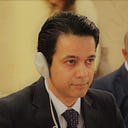America Is Pitched Against Its Former Iranian Allies in Iraq
The Iran-backed militias that played a key role in the successful American invasion of Iraq in 2003 are today gathered outside the U.S. Embassy in Baghdad. The protesters who attacked the embassy come from militias and groups that today are part of the Iraqi government but profess open loyalty to the neighboring government of Iran. And yet, they have been partners with America in ruling Iraq for 16 years.
This is not a riddle but likely one of the most interesting examples of realpolitik in the Middle East.
Some of these militias were trained and equipped by America but work for Iran.
These ‘proxy protesters’ from Kitaib Hezbollah are part of the Iraqi government, and they are different from the good protesters, the anti-government protesters who occupy Al-Tahrir Square in central Baghdad who issued a statement yesterday disowning the attack on the embassy and have openly accused militias and groups in the Iraqi government of involvement.
More amazingly, video clips have been uploaded on Twitter that show Iraqi security forces cooperating with Kitaib Hezbollah mobs in opening the gates into the Green Zone that houses the embassy.
So, in short, the attackers you see on TV trying to burn the American embassy were allies of America, and still are, in a roundabout way.
The United States would not be in control of Iraq today without the help of Iran-backed militias whose members are laying siege to the embassy.
Washington’s tenuous hold over Iraq is partially credited to the direct and indirect help of Ayatollah Khamenei and the IRGC, the Islamic Revolutionary Guard Corps. Iran created and used proxy Iraqi Shia militias and clerics to convince the Iraqi Shia majority to stand down as American and British troops passed through their territory in 2003. These Iraqis complied. This helped America seize Baghdad in no time.
[I accompanied U.S. Army and British forces in the invasion in March 2003 and spent nearly six months in southern Iraq living partly in the house of an Iraqi Shia family whose patriarch was a Sayyid, a caste revered by Shia Muslims. Several months into the invasion, when Iraq started going wrong, I recall that the patriarch had tears in his eyes as he told me that his people, the Shia-majority in the south, would not let foreign forces trespass their territory to Baghdad had Saddam “been nice to us.”]
Over the next 16 years, Washington and Tehran worked together on the ground in Iraq — and in Afghanistan — to share control. Today, pro-Iran proxies are in power in Baghdad and in Kabul, a testament to that undeclared alliance of convenience.
At times, the relationship was a limited location-based alliance, where American and Iranian military, intelligence, and diplomatic officers accommodated each other, and coordinated to eliminate common enemies in Iraq, and to some extent in Afghanistan, where Iran’s proxies consist of mostly Sunni Muslim warlords. There is little open discussion of this, partially because of the dearth of public evidence of this low-level American and Iranian coordination in the two theaters of war. This America-Iran overlap of interests did not fundamentally change the public postures of Washington and Tehran toward each other but likely played a role in making the nuclear deal achievable by 2015.
NOT WALKING INTO WAR
Notice how American and Iranian actions are calibrated despite the Iran-backed attack on an Iraqi base that killed an American contractor, the American retaliatory airstrike, and the resulting attempt to storm the embassy. The official American and Iranian actions and reactions are restrained despite the attempted storming of the largest American embassy in the world. This indicates a level of willingness on both sides to compromise despite the high stakes.
The clerical regime in Tehran wants decisive action now rather than wait until sanctions play out and weaken the regime beyond recovery. But the ayatollahs don’t want all-out war. They want to push Trump to accept a deal that lifts sanctions, and especially the debilitating oil export restrictions.
India, which enjoys a three-decade old strategic partnership with the Islamic Republic, making it the ayatollahs’ closest ally in the region, has advised Tehran to find a way out, now. New Delhi is concerned that a weakened Iran would allow nemesis Pakistan to have more say in the Afghanistan endgame, according to unconfirmed reports in Islamabad.
The American attack on an Iran-backed Iraqi militia does not hurt Iran, despite the high casualties. The entire Iranian game plan is built on absorbing attacks against its proxies, which largely consist of non-Iranian Shia jihadi fighters, motivated through high-fever religious indoctrination, which is a specialty of the Khomeinists ruling Iran since 1979.
Short of all-out war, the only option available to the Trump administration is to coexist with an intrusive Iran. Attacks on Iranian proxies do not hurt Tehran. Not Iranian blood. So, attacks against Hezbollah chapters across the region, militias in Syria and Iraq, and Houthis in Yemen, dent the clerics strategic armory but do not degrade its strength. What would hurt Iran? One answer could be IRGC targets inside Iran. Is United States ready to up the cost by attacking Iranian oil installations?
